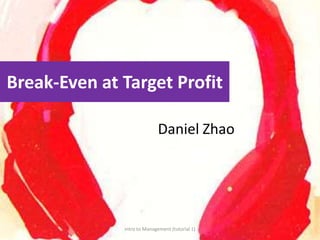
Break-Even Analysis
- 1. Intro to Management (tutorial 1) 1 Break-Even at Target Profit Daniel Zhao
- 2. Learning Objective Marketing Terms Basic Calculations used in the analysis of marketing problems Intro to Management (tutorial 1) 2
- 3. Contribution The funds available to the seller of an item after subtracting the variable costs associated with it are referred to as contribution. Unit contribution: the contribution per each item sold. Contribution = Sales – Variable Costs Intro to Management (tutorial 1) 3
- 4. Equations of Contribution Margin Contribution Margin (CM) Sales Price - Variable Cost = CM per unit Revenue - Total Variable Costs = CM in total Contribution Margin Ratio (CM%) Sales Price – Variable Cost Sales Price Intro to Management (tutorial 1) 4
- 5. Contribution : calculation example For example, we sell a unit of a product at a price of $100, and the variable manufacturing cost of that unit is $30; in addition, it costs us $3 for shipping and we paid 5% commission to salespeople. Total variable cost: $30 + $3 + $5 = $38 Contribution: $100 – $38 = $62 Intro to Management (tutorial 1) 5
- 6. Break-Even Break-even(BE) means that our revenue is just enough to pay for both the variable and the fixed costs we have incurred, but only that. We have no profit, we have no losses; we have only broken even. BE = Total fixed costs ÷ unit contribution Intro to Management (tutorial 1) 6
- 7. Break-Even: calculation example If the contribution is $62, and fixed costs are $100,000 BE = $100,000 ÷ $62 = 1,613 The break-even point here is 1,613 units Intro to Management (tutorial 1) 7
- 8. Profit Impact Unit × Units – Fixed Contribution Produced & Sold Costs = Profit Impact For example: $62 × $2,000 – 1,000 = $24,000 Why not just call it plain profit? … Intro to Management (tutorial 1) 8
- 9. Because… there may be a few other costs yet to be charged against the product. assume our target profit is $50,000, thus we add an additional cost to fixed cost Calculation: (Fixed + Profit + Additional ) ÷ Unit Contribution Cost Impact Fixed Cost = Req. Volume ($100,000 + 24,000 + 50,000) ÷ $62 = 2806 this means we have to make and sell 2806 units to yield the same profit Intro to Management (tutorial 1) 9
- 10. Break-Even at Target Profit Break-Even Point (Units) = Fixed Costs + Target Profit Unit Contribution Intro to Management (tutorial 1) 10
- 11. Question Sales Price/Unit $75 Unit Variable Cost (45) Unit Contribution $30 Fixed Costs = $200,000 Target Profit = $100,000 What should be the Break-Even unit to achieve a target profit at $100,000? Intro to Management (tutorial 1) 11
- 12. Answer: Break-Even Units = $200,000 + $100,000 $75 – $45 = 10,000 units Intro to Management (tutorial 1) 12
- 13. Break-Even Chart Intro to Management (tutorial 1) 13
- 14. Intro to Management (tutorial 1) 14 When fixed costs decrease by $20,000, break-even decreases by 4,000 units ($200,000).
- 15. B-E Calculation with Multiple Products For a company with more than one product, sales mix is the relative combination in which a company’s products are sold. Different products have different selling prices, cost structures, and contribution margins. Intro to Management (tutorial 1) 15
- 16. B-E Calculation Example for Multiple Products Intro to Management (tutorial 1) 16
- 17. Weighted-average Intro to Management (tutorial 1) 17 $200 × 62.5%
- 18. Intro to Management (tutorial 1) 18 Break-even point = Fixed Costs + Weighted-Average Unit Contribution Margin $170,000 ÷ $ 331.25 = 514 units
- 19. Questions? End of the tutorial Intro to Management (tutorial 1) 19
Hinweis der Redaktion
- Reference: http://hbsp.harvard.edu/multimedia/flashtools/breakeven/index.htmlGlossary:Break-even point: The break-even point occurs when the number of units sold multiplied by the contribution margin is equal to the fixed cost.Contribution margin: The contribution margin is the financial contribution that each unit sold makes toward covering fixed costs. It is the unit revenue minus the variable cost per unit.Fixed costs: Fixed costs are costs that do not vary with the number of units produced and sold.Operating leverage: Operating leverage describes the relationship between fixed and variable costs. Companies with high fixed costs relative to variable costs have high operating leverage.Variable costs: Variable costs are costs that do vary with the number of units produced and sold. Examples of variable costs include hourly labor, raw materials, and utilities; the more units manufactured, the more these items are consumed. As volume increases, variable costs per unit can increase or decrease depending on a number of factors.
- Variable costs: costs that are directly traceable to the volume of activity – the more we sell, the more raw materials we need, usually the more assembly work we need, and the more sales commission we pay.
- Assumptions:Company is operating within the relevant rangeRevenue and variable costs per unit are constantTotal contribution margin increases proportionally with increases in unit salesTotal fixed costs remain constantMixed costs are separated into variable and fixed elementsNo change in inventory (production equals sales)No change in capacitySales mix remains constantAnticipated price level changes included in formulasLabor productivity, production technology, and market conditions remain constant
- Assume in the previous example, we have a target profit in mind – a profit impact of $50,000.
- Resource: Bryant University
- Limitation:Linearity of revenueLinearity of variable costFixed costs cannot be changedNo uncertaintySingle period analysisValid only for given product mixProfit maximization is not the criterionUsed to answer “what if” questionsAssumes that capacity is always available